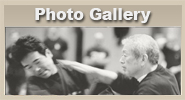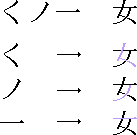Navigation
- Budo & Ninpo
- Members / Kunoichi
- Masaaki Hatsumi
- Tomoe Gozen
- Kunoichi [Female Ninja]
- Seminars & Taikai
- Budo on Web
- Contact Us
 |
 |
Kunoichi [Female Ninja]
A kunoichi is a female ninja.
As with the male ninja, they were spies and helped with the ninja's fight (in various different ways) against the samurai. Mistress of deception and 'flowery combat' were among their skills. She was a spy, messenger and observer. Her training, although similar to her male counterparts, focused more on the psychological techniques, including manipulation, disguise, feminine charm and the use of female intuition.They were also taught how to not only play with the emotions of others, but to keep their own emotions in check - they were not allowed to fall in love with their targets!! Hatsumi Sensei says that Female ninja were classified as part of the kamae of sui (water) and were cultivate to manipulate energy through preying on increased feelings of emotional satisfaction; like the ocean, they would draw out, only to come back, like a wave at riptide, in unexpected ways.
These women, or kunoichi as they were called, were given special training in psychological skills and intuition. Taught to manipulate men high-up in the enemy hierarchy, they were known to conceal blades inside musical instruments and sex toys. Shimma kunoichi, ninja family members, were trained as spies who were taught not to fall in love with their targets or lose sight of their ultimate goal after successful seduction. According to Rumiko Hayes, a ninja black belt and the wife of Stephen Hayes, head female agents were sent around the country to collect young female orphans, whom they raised with care. These orphan girls were forever indebted to their agents and would do whatever they were asked in terms of seducing men. Karima kunoichi were women who were not part of the clan but were temporarily hired as maids, mistresses, entertainers, fortunetellers, prostitutes, or artists. In contemporary times, female ninja often fulfill the same roles as men, working in security and law enforcement.

Apparently, one of the favourite weapons for a kunoichi was the neko-te (cat hand). The neko-te were usually used by the female kunoichi. The weapon is strong iron fingernails that were fastened into leather bands fitted on the fingers, and resembled claws (not that like or of the shuko, ashiko) and were also dipped in poisons. The eyes were a favorite spot for slashing.
One of the interesting things that my Japanese high school friend told me about the word kunoichi was the way it also means "woman" (onna) when put together.
In Japanese, the 'ku' is written in hirigana, 'no' in katakana and 'ichi' in kanji - add the three together, as in the image below, and you get the Japanese word (in kanji) for woman! The Kunoichi were a secret sisterhood in Ancient Japan. These women were experts in deception and masters of assassination. Female shrine attendants, concubines and servants moved about a Feudal Lord's castle with ease. Since these women went virtually unnoticed, they were capable of committing acts of espionage with little or no interference. Kunoichi-jutsu revolves around the art of deception. These warrior-women base their training on surprise tactics and hidden weapons. A Kunoichi never wastes time or energy in combative situations. Their unarmed fighting and weaponry skills make use of strategically placed vital attacks that are designed to incapacitate their opponents very quickly. Ever-vigilant, the Kunoichi is never a victim. Although she may appear weak and helpless, it is a ruse. In reality, the Kunoichi uses her outward appearance and conditioned emotional responses to manipulate those who would cause her harm.
Derivation of the word Kunoichi
The term is thought to derive from the names of characters that resemble the three strokes in the Japanese kanji character for woman ( 女 , onna); said in the order they are written: ku ( く ) - no ( ノ ) - ichi ( 一 ). However, this may be a modern fake etymology , as the ninja of the time wrote it as 九の一 (one of nine) or 九一 (nine one); [ dubious — see talk page ] these transliterations supposedly come from the fact that all humans have nine openings in common, but women have one more in addition; hence a woman is "one of nine" or "nine plus one". This however could be another fake etymology. It is also worth noting that the " くノ一 " writing requires the use of one character from each Japanese "alphabet". First hiragana , then katakana , then kanji. While hiragana and kanji can exist in the same word, katakana generally cannot appear in conjunction with the others, although there are exceptions to this, e.g. " ゴミ箱 ", " 消しゴム ".
Another proposed etymology, possibly as spurious as the others, would derive the term from 九 能 ("nō" : talent ) 一 , meaning nine talents in one person, though no creditable source lists these "nine talents".





Είστε γυναίκα και θέλεται να μάθετε γρήγορα και αποτελεσματικά; Θέλετε να αποκτήσεται αυτοπεπυθηση και να μπορείτε να διμιουργήσετε ένα πολεμικό και ακλόνιτο πνεύμα; Ελάτε στο Βujinkan Greece μαθένοντας άοπλη και ένοπλη μάχη.
Τεχνικές αντιμετόπησης πραγματικών συνθηκών!
